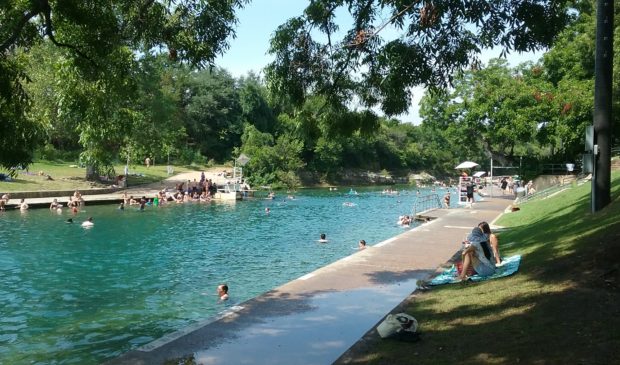City shares reason for Barton Springs’ cloudy water last December
Monday, June 24, 2019 by
Jessi Devenyns After Barton Springs was closed for a few days last December following an unusual level of turbidity in the water, the city immediately began investigating the cause.
As the plumes of sediment filling the freshwater pool settled, instruments measuring water quality led staff to discover that some geothermal well drilling about 4,000 feet from Barton Springs had hit an air void below the water table.
Geothermal wells (or heat pumps) can be installed to pump water under residences to act as a heating and cooling system. The driller on this particular project had acquired the proper permitting, but unexpectedly intersected a void within the aquifer, which resulted in sediment being injected into a public waterway.
Discharging a pollutant into a waterway is a code violation, and the city filed charges against the driller.
‘The driller paid a fine and we moved on,” David Johns with the Watershed Protection Department told the Environmental Commission at its June 19 meeting.
Although it did not take long for Watershed Protection staff to discover the culprit for the cloudy water, the event “exposed a gap in our knowledge about what could impact the springs,” said Johns.
A large part of the reason for that gap is that this type of well drilling is a new phenomenon in Austin, and per the city’s website, “the impact was not anticipated.”
To fill in that knowledge gap and prevent another turbidity event from occurring, the city and Watershed Protection have established new notification and drilling protocols associated with wells in the Barton Springs Zone, including new well depth limitations and additional oversight for drilling.
Although these geothermal systems are not common, according to Johns, they are becoming more prevalent. The city wants to ensure there are proper protocols to help keep plumes of sediment from being dispersed around the aquifer, potentially affecting plant and animal life.
The December event was not an acute event and city biologists have been monitoring its effects on the Barton Springs salamander. “We didn’t notice any unusual activity,” said Johns.
Unusual activity was confined to the three back-to-back turbidity events that occurred between Dec. 18 and Dec. 20 last year. The sediment was not dangerous and there have been no long-term effects.
“We feel like we have done our homework now,” said Johns, who reassured commissioners that the city has “greatly reduced the risk of this happening in the future.”
Photo: Outdoor Craziness [CC BY-SA 3.0], via Wikimedia Commons.
The Austin Monitor’s work is made possible by donations from the community. Though our reporting covers donors from time to time, we are careful to keep business and editorial efforts separate while maintaining transparency. A complete list of donors is available here, and our code of ethics is explained here.
You're a community leader
And we’re honored you look to us for serious, in-depth news. You know a strong community needs local and dedicated watchdog reporting. We’re here for you and that won’t change. Now will you take the powerful next step and support our nonprofit news organization?






